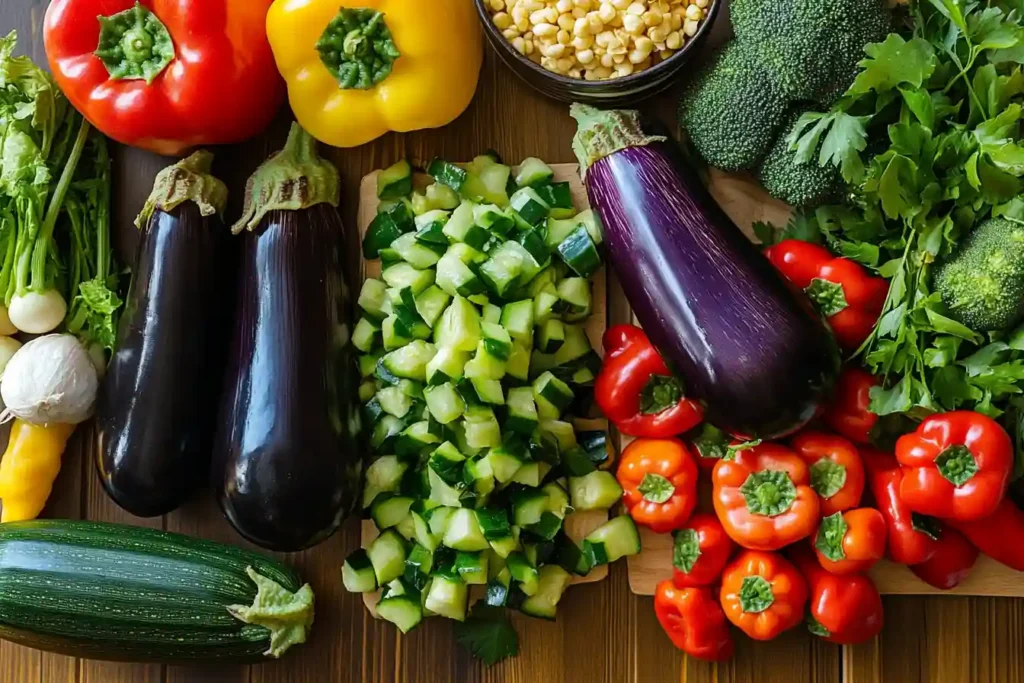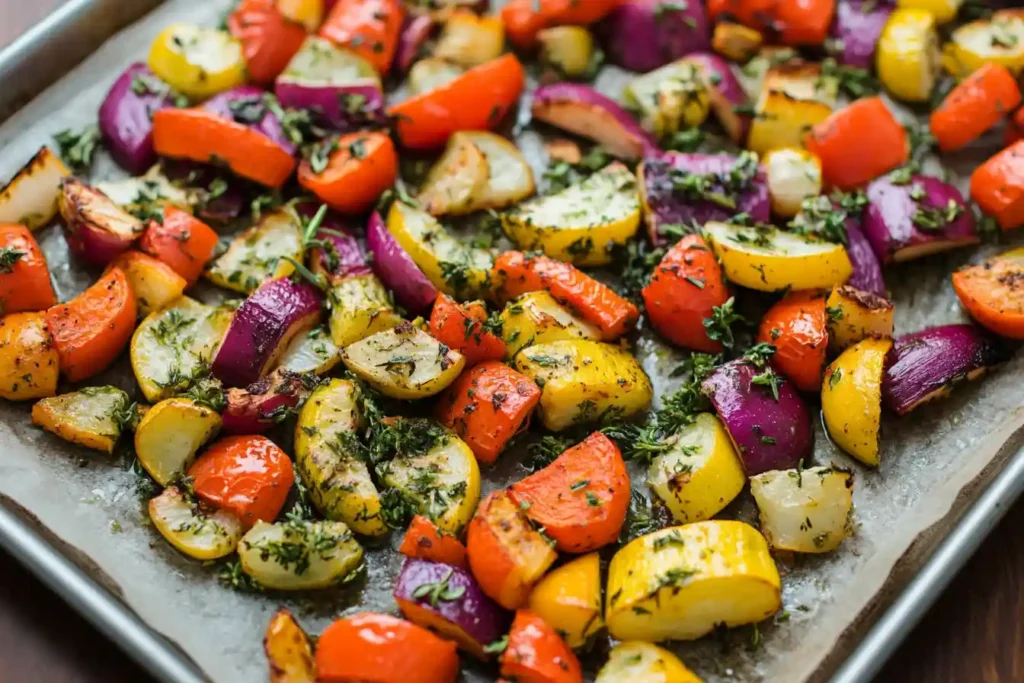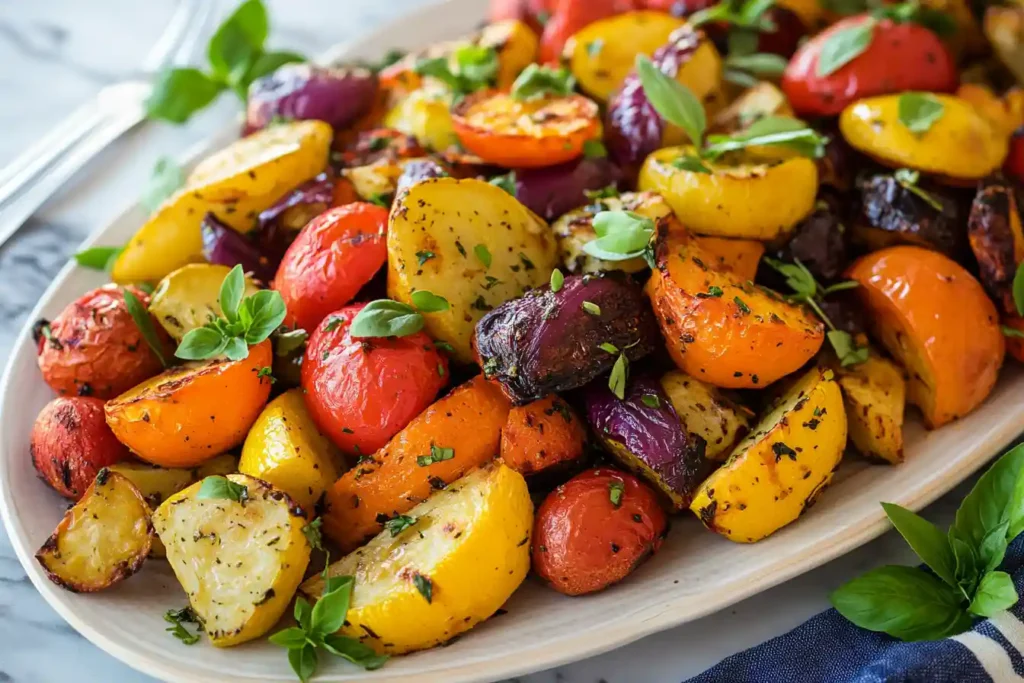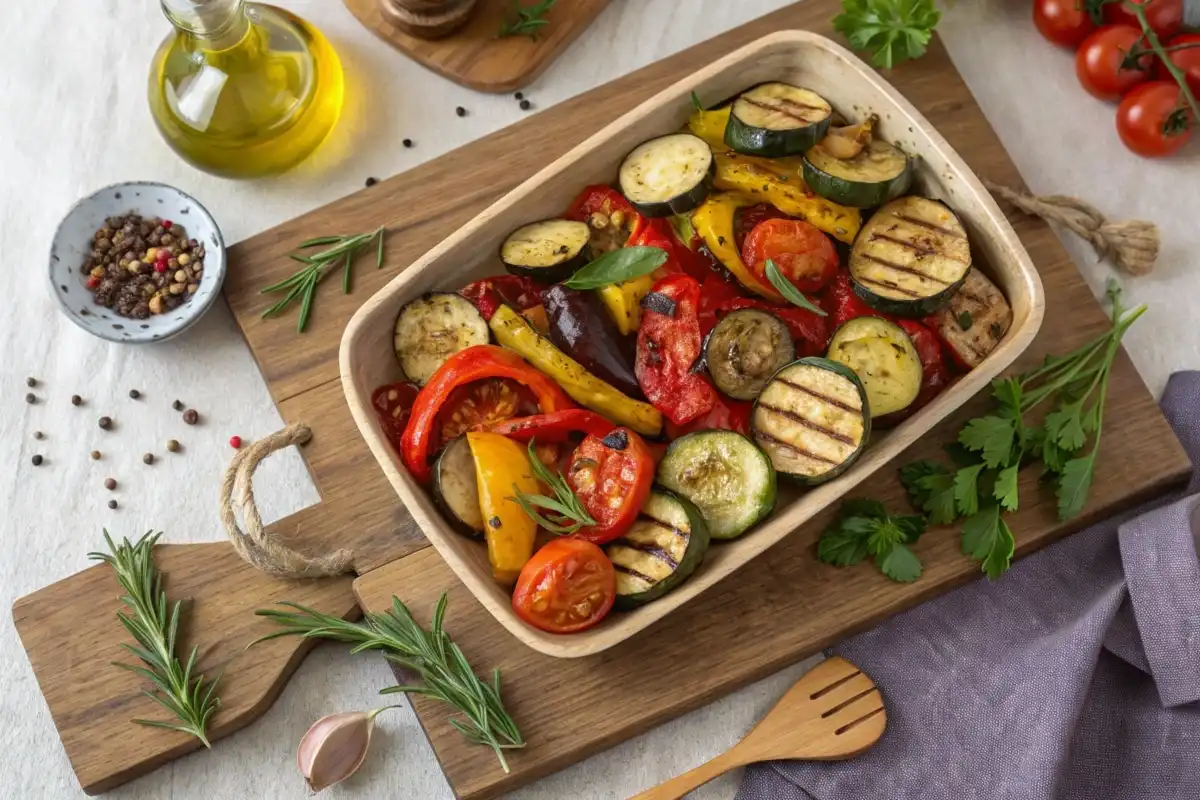Savor the bright flavors of Mediterranean roast vegetables, a healthy delight for any table.
Table of Contents
Introduction
I’ve always been drawn to meals that are both comforting and packed with bright, fresh flavors. That’s why I love preparing Mediterranean roast vegetables. They bring together the best of the Mediterranean diet: vibrant produce, heart-healthy olive oil, and aromatic herbs. However, what truly makes them special is the effortless way they transform even the simplest dinner into a memorable feast.
For example, the first time I roasted eggplants, zucchini, and bell peppers together, I couldn’t believe how the oven amplified their natural sweetness and infused them with a subtle, smoky taste. In addition, incorporating signature Mediterranean elements—like fresh herbs and a dash of lemon—took my veggies to a whole new level. Therefore, I often encourage family and friends to try this easy method as a gateway to a healthier lifestyle.
If you’re new to these flavors or simply want to expand your repertoire, I highly recommend exploring Common Vegetables in Mediterranean Cuisine to gain insights into the produce widely used in this region. In my experience, once you learn to roast veggies the Mediterranean way, it’s hard to go back to a plain old boiled side dish.

Why Roast Vegetables the Mediterranean Way
I’ve found that oven-roasting brings out a certain depth of flavor you just can’t achieve with steaming or sautéing. Therefore, it has become my go-to technique for showcasing the natural sweetness of produce. Moreover, using classic Mediterranean elements—like good-quality olive oil, fresh herbs, and a hint of citrus—ensures every bite bursts with brightness.
Another reason I adore this cooking style is how it preserves the vegetables’ nutrients. Roasting at relatively high heat not only caramelizes the veggies but also retains their vitamins, minerals, and fiber. Furthermore, the process itself is so straightforward: chop, season, roast, and enjoy. When I’m short on time, I can always rely on Mediterranean roast vegetables to deliver a meal that tastes both comforting and sophisticated.
If you want to dive even deeper into this approach, it helps to note that Mediterranean cuisine often features ingredients that pair well together, like onions and peppers, or tomatoes and zucchini. Pairing complementary flavors is key to achieving a harmonious dish. Therefore, consider mixing an assortment of veggies so each forkful is a delightful new taste experience.
Choosing Your Vegetables
Picking the Perfect Produce
Selecting the right mix of vegetables can make or break your Mediterranean roasting adventure. What vegetables are best for roasting? In my kitchen, I typically reach for eggplants, zucchini, bell peppers, tomatoes, onions, and sometimes carrots or potatoes. I aim for a blend of firm and soft varieties to ensure a satisfying mix of textures.
In addition, I love incorporating a rainbow of colors—deep purple eggplants, bright red peppers, and sunny yellow squash—because colorful produce often indicates a diverse range of vitamins and antioxidants. If you’d like more inspiration, check out Best Vegetables for Roasting to see how each veggie behaves under high heat and which ones complement one another.
Texture & Flavor Profiles
In my opinion, it’s important to pick vegetables that balance each other out. For instance, combining softer vegetables like zucchini or tomatoes with firmer ones like carrots or potatoes helps ensure you get contrasting textures. Meanwhile, bell peppers and onions add a subtle sweetness that counters the slight bitterness of eggplants.
I also pay attention to how various vegetables taste when they’re roasted. For example, eggplants take on a creamy interior and smoky exterior, while onions become sweet and caramelized. Therefore, don’t be afraid to experiment with different combinations to discover your personal favorite. In the end, trust your taste buds—they never lie.

The Best Herbs and Seasonings for Mediterranean Roast Vegetables
Essential Herb List
One of the most common questions I hear is, “What herbs to put on Mediterranean vegetables?” In my kitchen, oregano, thyme, rosemary, garlic, and parsley are absolute must-haves. In addition, I occasionally add a sprinkle of basil for extra freshness. While fresh herbs deliver a more vibrant taste, dried herbs can hold their own—plus, they’re convenient to keep in your pantry.
I always like to remind friends that the Mediterranean diet is famous for its reliance on simple, natural flavors. For instance, just a few sprigs of fresh rosemary can elevate roasted potatoes or carrots, while oregano adds a bold aroma to zucchini or tomatoes.
Seasoning Combinations
I often combine dried oregano and thyme with a clove or two of crushed garlic, drizzling the mixture over the vegetables. Furthermore, a pinch of chili flakes can give everything a subtle kick. Meanwhile, you can use transition words like “for instance” and “furthermore” in your own kitchen repertoire—mixing fresh basil at the end of roasting for a burst of garden-fresh flavor.
However, be cautious not to overwhelm the vegetables with too many competing herbs. I stick to two or three main herbs and let the vegetables’ natural taste shine through. Balancing flavors is key: for example, rosemary pairs well with thyme for hearty vegetables, whereas oregano and basil are ideal for tomatoes and zucchini.
Salt & Pepper Basics
It’s easy to underestimate the impact of proper seasoning. I prefer to use a fine sea salt or kosher salt, mixing it in with the herbs and olive oil. In addition, I grind fresh black pepper over the top just before the vegetables go into the oven. Tasting your veggies before they roast—and adjusting if needed—ensures the seasonings distribute evenly and highlights the bright Mediterranean flavors.
Creating a Signature Sauce
What Sauce Goes with Mediterranean Vegetables?
I’ve experimented with numerous sauces and dressings, and I find that a simple yogurt-based or tahini-based sauce works wonders with roasted vegetables. A drizzle of good-quality olive oil, fresh lemon juice, garlic, and herbs can also create a light, refreshing topping. If you’re wondering, “What sauce goes with Mediterranean vegetables?” try whisking together plain yogurt, a pinch of salt, a squeeze of lemon, and some minced garlic for a tangy dip.
Alternatively, you can mix tahini (sesame seed paste) with a little warm water, fresh lemon juice, and a pinch of cumin. This sauce is creamy yet nutty, and it contrasts beautifully with the natural sweetness of roasted veggies. Therefore, if I’m looking for something heartier, I sometimes stir in chopped fresh parsley and a dash of paprika.
Homemade Dressing Variations
Another approach I love is making a quick vinaigrette for post-roast drizzling. For instance, whisk extra-virgin olive oil with lemon juice or red wine vinegar, toss in a teaspoon of Dijon mustard, and sprinkle with dried herbs. On the other hand, if you prefer a thicker texture, combine some Greek yogurt or hummus with lemon juice and a little bit of water. This adds creaminess without weighing down the dish.
Ultimately, the sauce you choose should complement, not overpower. In my experience, a tangy, herb-forward sauce highlights the roasty, caramelized flavors of the vegetables. Additionally, feel free to play around with fresh dill, parsley, or even mint to see which flavors best suit your taste.
Tips & Techniques for Perfect Roasting
Prepping Your Ingredients
I always start by rinsing each vegetable thoroughly, then patting them dry to ensure a better roast. One key tip is to chop them into uniformly sized pieces, so they cook at the same rate. For example, if you’re working with bell peppers and zucchini, aim for bite-sized chunks. This consistency matters because smaller pieces will roast faster, while larger ones might remain undercooked.
Once chopped, I toss everything in a large bowl with olive oil, herbs, and seasonings. Therefore, every single piece gets coated evenly, which helps produce a consistent flavor. Plus, doing this in a bowl simplifies cleanup—something I always appreciate.
Temperature & Cook Times
Through trial and error, I’ve found that 400–425°F is ideal for caramelizing the vegetables without drying them out. In addition, flipping them halfway through the roasting process promotes even browning. For instance, I often roast veggies for about 25–35 minutes total, adjusting based on the density of each vegetable. Meanwhile, you can keep an eye on the edges—when they turn golden-brown and start to crisp, that’s usually your signal they’re ready.
Avoiding Common Mistakes
One pitfall to avoid is overcrowding the baking sheet. If too many pieces are crammed together, they’ll steam rather than roast. Therefore, I always make sure there’s a bit of space around each vegetable chunk. Additionally, I’ve learned not to overdo the olive oil; excess oil can lead to soggy results. It’s better to start with a light coating and add more if necessary.
Variations & Serving Suggestions
Pairing with Proteins & Grains
Sometimes I like to turn these Mediterranean roast vegetables into a full meal. You can serve them alongside grilled chicken or fish if you eat meat, or pile them on top of hearty grains like quinoa or brown rice for a vegetarian-friendly option. For an extra punch of flavor, I’ll drizzle a bit of lemon juice over everything.
When I’m seeking a lighter lunch, I stuff them into a whole-wheat pita with hummus or layer them over a crispy flatbread. Furthermore, these veggies make fantastic leftovers; I often toss them into a salad or reheated grain bowl the next day.
Mediterranean-Inspired Add-Ons
Since I’m a fan of mixing flavors, I sometimes include olives, sun-dried tomatoes, or crumbled feta cheese once the vegetables come out of the oven. Meanwhile, adding these ingredients too early can lead to over-salting or burning, so I like to wait until the end.
If you’re craving more Mediterranean ideas, you might check out Greek Recipes: Delicious Mediterranean Journey. I find that once you master the roasting basics, you can branch out to a variety of Mediterranean-inspired dishes.
Recipe: Mediterranean Roast Vegetables

Below is my go-to recipe for Mediterranean roast vegetables—tried, tested, and loved in my own kitchen.
Ingredients
- 1 medium eggplant, cut into 1-inch cubes
- 2 zucchini, sliced into half-moons (about ½ inch thick)
- 2 bell peppers (any color), cut into chunks
- 1 red onion, cut into wedges
- 1 cup cherry tomatoes, whole or halved
- 3 tablespoons extra-virgin olive oil
- 2 teaspoons dried oregano
- 1 teaspoon dried thyme
- 1 teaspoon salt (or to taste)
- ½ teaspoon freshly ground black pepper
- 2 cloves garlic, minced (optional)
- Juice of ½ lemon (optional, for finishing)
Optional Add-Ons
- A handful of pitted olives (mixed varieties)
- Crumbled feta cheese (add after roasting)
- Fresh basil or parsley, chopped
Step-by-Step Instructions
- Preheat Your Oven
- First, preheat the oven to 425°F.
- Meanwhile, line a large baking sheet with parchment paper if you prefer easier cleanup.
- Gather and Prep Vegetables
- Rinse and dry all produce.
- Slice eggplant, zucchini, and bell peppers into similar-sized chunks; slice onion into wedges.
- If using cherry tomatoes, decide whether to halve them or keep them whole.
- Combine with Seasonings
- Place all chopped vegetables in a large mixing bowl.
- Drizzle with olive oil, then sprinkle in the dried oregano, dried thyme, salt, pepper, and minced garlic if using.
- Toss everything together until every piece is evenly coated.
- Arrange on Baking Sheet
- Spread the vegetables in a single layer on the baking sheet.
- Be careful not to overcrowd; use two sheets if necessary.
- Roast and Flip
- Roast the veggies for about 15–20 minutes.
- Then, use a spatula or tongs to flip them so they cook evenly.
- Continue roasting for another 10–15 minutes, or until they develop a golden-brown color on the edges.
- Finish and Serve
- Remove from the oven and let the vegetables rest for a minute.
- Optional: Squeeze the juice of ½ lemon over the top for a final burst of brightness.
- Garnish with olives, crumbled feta, or fresh herbs if desired.

Personal Tips
- Parchment Paper Hack: I usually line the sheet pan with parchment paper to prevent sticking and ease cleanup.
- Finishing Touches: I find a quick drizzle of good-quality extra-virgin olive oil after roasting adds a silky finish.
- Storage: If you have leftovers, store them in an airtight container in the fridge for up to three days. Reheat in the oven or toss them cold into a salad.
Nutritional Information
Roasted vegetables provide a range of essential vitamins and minerals. Here’s an approximate breakdown per 100g serving of Mediterranean roast vegetables (without optional add-ons).
| Nutrient | Amount (per 100g) |
|---|---|
| Calories | 80 kcal |
| Total Fat | 3 g |
| Carbohydrates | 10 g |
| Protein | 2 g |
| Fiber | 3 g |
| Sodium | 200 mg |
Note: Values may vary slightly depending on the specific vegetable mix and amount of added salt.
Frequently Asked Questions
What are common vegetables in Mediterranean cuisine?
Common vegetables in Mediterranean cuisine often include eggplants, zucchini, tomatoes, onions, bell peppers, cucumbers, and leafy greens. The region’s diverse climate supports a wide variety of produce, and these veggies are frequently roasted, grilled, or eaten raw. If you want a detailed guide, head over to Common Vegetables in Mediterranean Cuisine.
What vegetables are best for roasting?
In my experience, vegetables with a sturdy structure—like carrots, potatoes, eggplants, onions, and bell peppers—roast particularly well. Softer options like zucchini and tomatoes can still be roasted; they just need a shorter cook time. For a deeper look at roasting techniques, check out Best Vegetables for Roasting.
What herbs to put on Mediterranean vegetables?
I typically reach for oregano, thyme, rosemary, and parsley. Basil is another favorite, though I usually add it fresh at the end. The Mediterranean region is known for these aromatic herbs, and using a combination can really enhance the dish. A little garlic doesn’t hurt, either!
What sauce goes with Mediterranean vegetables?
A simple yogurt-based sauce or a creamy tahini sauce pairs beautifully with Mediterranean roast vegetables. Alternatively, a quick vinaigrette made from olive oil and lemon juice also works wonders. The key is to complement—rather than overshadow—the natural flavors of the roasted produce.
Conclusion
Overall, Mediterranean roast vegetables have become a staple in my home. I love how they harness the vibrant flavors of the region and transform even the simplest meal into something special. By using high-quality produce, a drizzle of olive oil, and a medley of fresh herbs, I can easily create a dish that feels wholesome and indulgent at the same time.
If you’re searching for more ways to incorporate vegetables into your meals, feel free to explore additional recipes on Easy Eats Daily Home or pair these roasted delights with something like the Pea Pasta Recipe for a hearty dinner. After tasting the magic of the Mediterranean, I’m pretty sure you’ll find yourself roasting veggies more often than ever.

